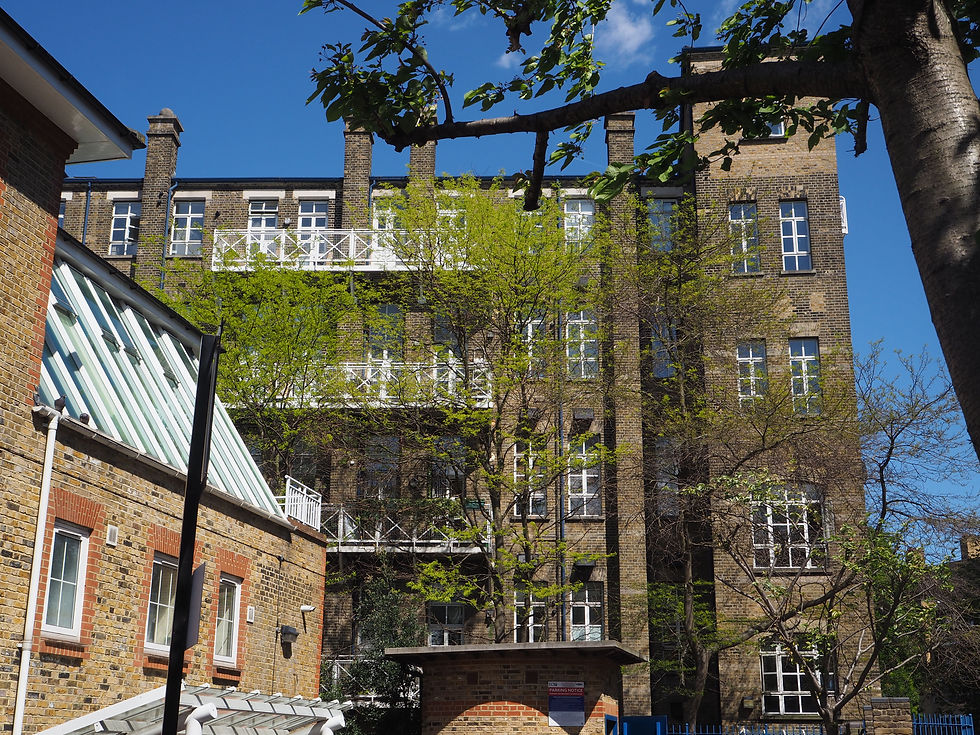Should you want to extend your Thames walk on the East end of London, you might like to include Dickens' evocative journalistic pieces and interesting asides to the novels. This is what I did when taking a lively group from the Cambridge branch of the Dickens Fellowship on a walk from the Tower to the Docklands Museum on a clear, bright day, perfect for literary walking.

On Wapping High Street (walking eastwards from the Tower and St Katharine’s Docks), opposite The Town of Ramsgate pub, is a small enclosed green area, the old graveyard to St John’s church. Enter this green, then cross diagonally to the houses on its east side, Scandrett Street. Look up and you will see two small figures of children in 1st floor alcoves.

These are two of the most beautiful ‘blue-coat school’ statues in London. They mark the place as a charity school – blue dye was cheap. Founded in 1695, the present building dates from 1765. The pupils continued to wear the distinctive costumes well into the 19th century (Christ’s Hospital School still does!), and it is such a costume that marks out ‘Rob the Grinder’ in Dombey and Son, to make him an easy target for bullies on his way home from the Charitable Grinders school.
‘The number of her son, I believe,’ said Mr Dombey, turning to his sister and speaking of the child as if he were a hackney-coach, is one hundred and forty-seven.’ … ‘The dress, Richards, is a nice, warm, blue baize tailed coat and cap, turned up with orange coloured binding; red worsted stockings; and very strong leather small-clothes. One might wear the articles one’s self,’ said Mrs Chick, with enthusiasm, ‘and be grateful.’
Return to Wapping High Street and continue eastwards, past the Marine Policing Unit described in the previous blog, then just before Wapping underground station, turn left up Wapping Lane, formerly Old Gravel Lane. Continue up Wapping Lane passing Prusom St on your right and further on St Peter’s Church. Take the path immediately after the church and cross Raine St continuing ahead slightly to your left onto Farthing Fields. The whole of this area on the east side of Raine St, stretching almost back to Prusom St, was once covered by St George in the East workhouse. The only section now remaining is the large dark brick building, flanked by taller brick towers, with (later) white iron balconies.

This is the workhouse Dickens visited and wrote about in ‘Wapping Workhouse’(1861) published in The Uncommercial Traveller. Dickens visited the women’s part of the workhouse and writes of the intelligent-looking matron who does her best with the limited funds available, but describes the so-called ‘foul wards’: dark, inconvenient garrets where dying women lay in beds on the floor: ‘The wretched rooms were as clean and sweet as it is possible for such rooms to be; they would become a pest-house in a single week, if they were ill-kept.’ He visits the ‘imbecile’ wards, where many of the inmates had fits; the ward of mothers and babies; the refractory wards, where recalcitrant girls from 16 to 20 were picking oakum, and the wards for the old and infirm, where there was patience and resignation but a total lack of hope, and not the place he thought where age should spend its last days. While he acknowledges that this workhouse is more scrupulously clean than places he had seen elsewhere, Dickens keeps his final social comments for total condemnation of the foul wards and the system whereby the poorest parishes, by necessity with the greatest number in workhouses, had the heaviest burden of payment of poor relief, while the richest parishes paid hardly anything. What, I wonder, would he say now at the present levels of inequality!
When you have finished exercising your imaginations and minds on contemplation of the former workhouse, turn back to Raine St, turn right and follow it round to the left. On your left before returning to Wapping Lane, notice that Raine’s House also has two blue-coat school statues in its alcoves, replicas to mark that this too was a charity school. Its original motto remains: ‘Come in & learn your duty to God & man. 1719’.
To be continued...

Comments